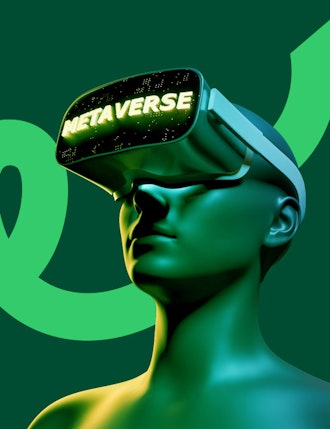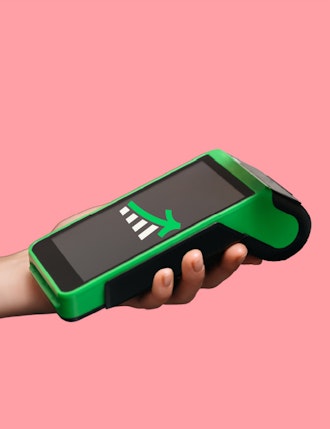How augmented reality is revolutionizing customer engagement and streamlining operations in banking

Key Insights
-
Augmented reality (AR) is revolutionizing banking by turning complex data into intuitive, interactive visualizations, helping merchants make better decisions on the spot.
-
AR is transforming customer engagement in banking, with interactive product demos, onboarding, and real-time support that simplify financial processes.
-
Bringing AR into banking connects the physical and digital worlds, creating seamless, engaging experiences that drive loyalty and trust.
-
While challenges like user adoption, integration, and security remain, AR holds the potential to redefine banking operations and financial services for the future.
Don't have time to read more now? Sign up to our newsletter to get the latest insights directly in your inbox.
Hold on, are you saying…
…A customer can walk into a bank branch and, through AR glasses, see virtual tellers ready to guide them through account setups, loan options, and even currency exchanges with no waiting, no queues?
And a merchant can be shown how to reconcile payments with a 3D overlay, right on their phone?
And that same merchant can point their phone at their store’s counter and see live transaction data hovering above it complete with color-coded sales spikes and best-selling products so they know what to stock up on?
Yes, that’s exactly what we’re saying, as this is the age of augmented reality in banking. And it is extremely exciting.
Reshaping how banks, merchants, and customers interact, augmented reality is how we, as payment providers go from delivering services to orchestrating experiences, connecting the dots between digital and physical in a way that’s never been possible before.
But what are the real opportunities and what challenges lie ahead?
Let’s take a quick dive into the trends shaping augmented reality in banking, showcasing practical use cases, and sharing our unique take on why AR is revolutionary for payments, operations, and customer experience.

The trends shaping augmented reality in banking
Augmented reality in banking is about solving real problems and unlocking new opportunities. Not to be confused with gamification, augmented reality in a banking and payments context is really about enhancing users’ experience, letting you see what could be possible without committing to it. Let’s break down the trends making AR impossible to ignore.
1. Data visualisation that actually helps
Merchants and business owners don’t need another complicated dashboard. They need to see where their cash flow stands, how sales are performing, and what’s driving loyalty, and quickly too. AR brings data to life with interactive, 3D overlays that make complex information instantly understandable and available fast.
2. Interactive product demos at the point of sale
Ever tried explaining a loan product to a customer who’s already overloaded with choices? AR steps in with interactive product tours, videos, and real-time calculators that show customers exactly what they’re getting. Scan a poster in a branch or point a phone at a leaflet, and suddenly mortgage comparisons or investment options come alive.
3. Onboarding and training is super simplified
Training new staff or onboarding merchants shouldn’t feel like wading through a manual. With AR, processes are visual and hands-on. Imagine a merchant scanning their new payment terminal and getting an interactive guide that walks them through setup, troubleshooting, and tips, without the jargon. That’s AR making complex tasks simple, consistent, and quick.
4. Real-time support and compliance at their fingertips
When a merchant faces a payment dispute or needs to understand a new regulation, AR can overlay answers right where they’re needed on the device they’re using. Interactive tutorials, instant support, and step-by-step compliance checks can all live in the AR layer, keeping operations smooth and trust high.
Making augmented reality a reality in payments
At Aevi, we see AR as a powerful tool to help merchants and financial institutions transform complex payment processes into intuitive, interactive experiences. AR has the potential to:
- Connect the dots between digital insights and physical interactions, helping merchants close gaps between data, devices, and customers.
- Turn data into action by overlaying transaction insights, sales trends, or loyalty stats in the moments that matter most, so merchants can make smarter decisions right there and then.
- Empower merchants to help themselves, with real-time guidance on device setup, troubleshooting, and compliance, reducing the need to wait for call centers or flipping through dense manuals.
- Keep trust front and center, with built-in PCI DSS compliance, real-time fraud detection, and secure device integration, because innovation means nothing without security.
- Optimize physical layouts and workflows, using AR to visualise foot traffic, transaction hotspots, or terminal placement, empowering merchants to refine in-store flow for better efficiency and customer experience.
However, as exciting as AR is, it’s not without its hurdles, especially in an industry where trust and compliance are paramount…
Potential challenges of augmented reality in banking
- User adoption - Many merchants and customers are still unfamiliar with AR tools, and the learning curve can be steep. Without clear onboarding, AR features might feel more like gimmicks than helpful solutions.
- Security and privacy - Overlaying data in the physical world introduces new risks, from unauthorized data capture to potential misuse of sensitive financial information. It’s critical to integrate AR within secure, PCI DSS-compliant frameworks.
- Integration complexity - AR doesn’t operate in a vacuum. It needs to work seamlessly with existing payment systems, apps, and devices, which can be complex in fragmented ecosystems.
- Cost of implementation - Developing and deploying AR solutions can be resource-intensive. For many institutions, demonstrating ROI is key to justifying investment.
At Aevi, we see these challenges as opportunities to enable smarter, more secure AR experiences, powered by the same orchestration, compliance, and security layers that merchants and PSPs already trust to connect digital and physical commerce.
Augmented reality X Aevi’s orchestration layer
So, where does augmented reality in banking go from here? Will it become the essential layer that empowers merchants with instant insights, smarter decisions, and seamless support? Or will it remain just another digital trend, waiting for the right orchestration partner to make it real?
At Aevi, we believe the answer lies in how we bring AR to life - securely, intuitively, and with real-world outcomes that merchants can trust.
Could this be the moment payments evolve from transactions to truly interactive experiences?
With the right orchestration layer, innovations like AR become easier to explore, integrate, and scale. Want to see how your payments infrastructure can open the door to what’s next? Let’s talk.
Interested in reading more around this subject? Here are some useful articles…












